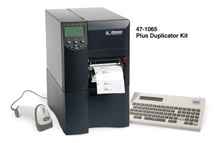Acid-Free Bar Code Labels for Archival Use
 Since many museums and libraries use bar code labels for special collections, it is important that these labels are acid-free so that they cannot harm the surface they are placed on. Older books, letters, photos, maps, paintings, and other items that might exist in a special collection require special care and treatment to stay well preserved. Bar codes can help to track detailed information about each item, including its material composition, date of origin, and provenance. Archival bar code labels are safe to use on rare items must meet certain standards. Some archival bar code label companies, such as Hightower, offer labels made from recycled paper which is safe to use for archives. But it is not just archival bar code labels alone that are offered by companies like these, for they also have scanners and printers designed just for use with these labels.
Since many museums and libraries use bar code labels for special collections, it is important that these labels are acid-free so that they cannot harm the surface they are placed on. Older books, letters, photos, maps, paintings, and other items that might exist in a special collection require special care and treatment to stay well preserved. Bar codes can help to track detailed information about each item, including its material composition, date of origin, and provenance. Archival bar code labels are safe to use on rare items must meet certain standards. Some archival bar code label companies, such as Hightower, offer labels made from recycled paper which is safe to use for archives. But it is not just archival bar code labels alone that are offered by companies like these, for they also have scanners and printers designed just for use with these labels.
(Photo courtesy of Computype)
Gaylord offers the 47-1065 Plus Duplicator Kit which can print a high volume of bar code labels but also has the advantage of duplicating a bar code that already exists in an archival collection. The benefit of having a duplicate label is so that it can be attached to a paper record in the archive if an electronic record of a certain item is not available. The kit includes a hand held scanner, a thermal transfer printer, and is ideal for printing out more than 25,000 labels a year. Polypropylene labels can be purchased separately for printing. Gaylord thermal transfer labels will not fade once the bar codes are printed on them. Gaylord printers use polymerized inks that will not smudge when the bar code labels are printed.
 Long lasting archive safe bar code labels can also be acquired through Highsmith, a leader in the industry of archival bar code products. Their labels meet the ANSI/NISO specification for paper permanence, which means that these bar code labels will last for several hundred years before they begin to degenerate. These labels are perfect for the environmentally conscious archive as they are manufactured from recycled paper fibers and are pH-neutral. Highsmith also provides bar code label protectors that are clear and can be placed directly over the actual label. In addition to the protectors, the company also offers a bar code duplicating system that allows the user to create duplicate bar code labels without the aid of a computer. In place of a computer, the duplicating system is comprised of a scanner, small keyboard, and thermal printer which does the job quickly and efficiently. Bar code scanners and readers can also be purchased through Highsmith by museums and other non-profit organizations that use archives.
Long lasting archive safe bar code labels can also be acquired through Highsmith, a leader in the industry of archival bar code products. Their labels meet the ANSI/NISO specification for paper permanence, which means that these bar code labels will last for several hundred years before they begin to degenerate. These labels are perfect for the environmentally conscious archive as they are manufactured from recycled paper fibers and are pH-neutral. Highsmith also provides bar code label protectors that are clear and can be placed directly over the actual label. In addition to the protectors, the company also offers a bar code duplicating system that allows the user to create duplicate bar code labels without the aid of a computer. In place of a computer, the duplicating system is comprised of a scanner, small keyboard, and thermal printer which does the job quickly and efficiently. Bar code scanners and readers can also be purchased through Highsmith by museums and other non-profit organizations that use archives.
Vernon is a name well known to libraries across the nation, and like Highsmith and Gaylord, provides bar code labels for laser printing. In addition to archival safe bar code labels, Vernon carries polyester label protectors, bar code duplicators similar to those of Highsmith, and scanners. With a wide variety of acid-free bar code labels to select from, a museum or library can safely use them for organizing and maintaining their archives.
http://www.vernonlibrarysupplies.com
Related articles:
Morovia EAN Bookland Bar Code Software for Books
Printing Bar Codes with PastPerfect Software for Museums
Creating Code 39 Bar Codes for Library Books
{jcomments on}
